Development and Validation of Reliability Testing Methods for Insulation Systems in High-Voltage Rotating Electrical Machinery on Ships
Abstract
:1. Introduction
1.1. Background
1.2. Limitations of Previous Methods
1.3. Comparison with Reliability Standards in Other Industries
2. Materials and Methods
2.1. Thermal Evaluation
2.2. Electrical Evaluation
2.3. Multifactor Evaluation (Thermal + Electrical)
2.4. Thermomechanical Evaluation
2.5. Test Specimens
3. Results and Discussion
3.1. Testing
3.2. Test Results and Conformation with Evaluation Criteria
3.3. Specimens Before and After Testing
3.4. Discussion
4. Conclusions
- Thermal evaluation: a mean breakdown time of 7056 h, significantly exceeding the IEC standard of 5000 h;
- Electrical evaluation: a mean breakdown time of 5040 h, demonstrating that the insulation system can withstand prolonged electrical stress;
- Multifactor evaluation: a breakdown time of 258.5 d, reflecting the combined resilience of the system under simultaneous thermal and electrical stresses;
- Thermomechanical evaluation: a 63rd percentile breakdown time of 245.7 h, highlighting the durability of the system under combined mechanical and thermal stresses typically encountered onboard ships.
Author Contributions
Funding
Institutional Review Board Statement
Informed Consent Statement
Data Availability Statement
Conflicts of Interest
References
- Ivanova, M.; Barudov, E. Investigation of the electromagnetic field of marine high-voltage power transformers regarding the safety of the ship personnel. In Proceedings of the 2022 14th Electrical Engineering Faculty Conference (BulEF), Varna, Bulgaria, 14–17 September 2022; pp. 1–4. [Google Scholar] [CrossRef]
- Roh, C.; Jeon, H.M.; Kim, S.W.; Kim, J.S.; Lee, N.Y.; Song, S.W. Optimal hybrid pulse width modulation for three-phase inverters in electric propulsion ships. Machines 2024, 12, 109. [Google Scholar] [CrossRef]
- Hong, S.H.; Kim, D.M.; Kim, S.J. A Back–forward approach-based efficiency performance analysis model for hybrid electric propulsion ships using the Holtrop–Mennen Method. J. Mar. Sci. Eng. 2023, 12, 1. [Google Scholar] [CrossRef]
- Camara, M.B.; Dakyo, B. Coordinated Control of the hybrid electric ship power-based batteries/supercapacitors/variable speed diesel generator. Energies 2023, 16, 6666. [Google Scholar] [CrossRef]
- Gan, S.; Shi, W.; Xu, X. Proposed Z-source electrical propulsion system of a fuel cell/supercapacitor-powered Ship. J. Mar. Sci. Eng. 2023, 11, 1543. [Google Scholar] [CrossRef]
- Uyanık, T.; Bakar, N.N.A.; Kalenderli, Ö.; Arslanoğlu, Y.; Guerrero, J.M.; Lashab, A. A Data-driven approach for generator load prediction in shipboard microgrid: The chemical tanker case study. Energies 2023, 16, 5092. [Google Scholar] [CrossRef]
- Ma, F.; Qi, L.; Ye, S.; Chen, Y.; Xiao, H.; Li, S. Research on fault diagnosis algorithm of ship electric propulsion motor. Appl. Sci. 2023, 13, 4064. [Google Scholar] [CrossRef]
- Kim, H.; Kong, T.; Lee, S.B.; Kang, T.-J.; Oh, N.; Kim, Y.; Park, S.; Lim, C.; Stone, G.C. Experience with stator insulation testing and turn/phase insulation failures in the power generation industry. IEEE Trans. Ind. Appl. 2018, 54, 3. [Google Scholar] [CrossRef]
- O’Donnell, P. Report of large motor reliability survey of industrial and commercial installations: Part I and II. IEEE Trans. Ind. Appl. 1985, 21, 853–872. [Google Scholar]
- Gavrilenko, V.; Leonov, A.; Bukharkin, A.; Hlioui, S.; Lefebvre, S. A method for endurance testing of enameled round and rectangular wires for motors controlled by SiC-based inverters. IEEE Trans. Dielect. Electr. Insul. 2021, 28, 2091–2098. [Google Scholar] [CrossRef]
- Viatkin, A.; Ricco, M.; Mandrioli, R.; Kerekes, T.; Teodorescu, R.; Grandi, G. Sensorless Current Balancing Control for Interleaved Half-Bridge Submodules in Modular Multilevel Converters. IEEE Trans. Ind. Electron. 2023, 70, 5–16. [Google Scholar] [CrossRef]
- Ji, Y.; Giangrande, P.; Zhao, H.; Zhao, W.; Madonna, V.; Zhang, H.; Galea, M.A. Electrical machine design considering corona-resistant wire for more electric aircraft applications. IEEE Trans. Transp. Electrific. 2023, 9, 2. [Google Scholar] [CrossRef]
- Rumi, A.; Marinelli, J.G.; Barater, D.; Cavallini, A.; Seri, P. The challenges of reliable dielectrics in modern aerospace applications: The hazard of corona resistant materials. IEEE Trans. Transp. Electrific. 2022, 8, 4646–4653. [Google Scholar] [CrossRef]
- Ghalebzade, F.; Molatefi, H.; Zahedi, R.; Daneshgar, S. Analyzing operational dynamics: Centralized load distribution and suspended wagons in self-propelled trains. Adv. Control Appl. 2024, 6, 4. [Google Scholar] [CrossRef]
- Boglietti, A.; Cavagnino, A.; Lazzari, M.; Pastorelli, M. A simplified thermal model for variable-speed self-cooled industrial induction motor. IEEE Trans. Ind. Appl. 2003, 39, 945–952. [Google Scholar] [CrossRef]
- Hamidreza, A.; Sareh, D.; Rahim, Z. Experimental investigation of gamma Stirling refrigerator to convert thermal to cooling energy utilizing different gases. J. Future Technol. 2023, 2, 2. [Google Scholar]
- Jiang, B.; Huang, X.; Liu, Y.; Nategh, S. Accelerated destructive experiment design of motor stator winding insulation systems. In Proceedings of the 2021 IEEE Workshop on Electrical Machines Design, Control and Diagnosis (WEMDCD), Modena, Italy, 8–9 April 2021; pp. 225–230. [Google Scholar] [CrossRef]
- Gegenava, A.; Khazanov, A. Statistical review of voltage endurance test of insulation for high voltage rotating machines stator windings with combined standard and accelerated tests. “Three Steps Test” TST. In Proceedings of the 2023 IEEE Electrical Insulation Conference (EIC), Quebec City, QC, Canada, 18–21 June 2023; pp. 1–4. [Google Scholar]
- Mizra, A.; Bazzi, A.; Nguyen, H.; Cao, Y. Motor stator insulation stress due to multilevel inverter voltage output levels and power quality. Energies 2022, 15, 4091. [Google Scholar] [CrossRef]
- Höpner, V.N.; Wilhelm, V.E. Insulation life span of low-voltage electric motors—A survey. Energies 2021, 14, 1738. [Google Scholar] [CrossRef]
- Baranov, G.; Zolotarev, A.; Ostrovskii, V.; Karimov, T.; Voznesensky, A. Analytical model for the design of axial flux induction motors with maximum torque density. World Electr. Veh. J. 2021, 12, 24. [Google Scholar] [CrossRef]
- IEC 60034-18-31-2012; Rotating Electrical Machines Part 18–31: Functional Evaluation of Insulation Systems Test Procedures for Form-Wound Windings Thermal Evaluation and Classification of Insulation Systems Used in Rotating Machines. International Electrotechnical Commission: Geneva, Switzerland, 2012.
- IEC 60034-18-32-2010; Rotating Electrical Machines Part 18–32: Functional Evaluation of Insulation Systems Test Procedures for Form-Wound Windings Evaluation by Electrical Endurance. International Electrotechnical Commission: Geneva, Switzerland, 2010.
- IEC 60034-18-33-2010; Rotating Electrical Machines Part 18–33: Functional Evaluation of Insulation Systems Test Procedures for Form-Wound Windings Multifactor Evaluation by Endurance Under Simultaneous Thermal and Electrical Stresses. International Electrotechnical Commission: Geneva, Switzerland, 2010.
- IEC 60034-18-34-2012; Rotating Electrical Machines Part 18–34: Functional Evaluation of Insulation Systems Test Procedures for Form-Wound Windings Evaluation of Thermomechanical Endurance of Insulation Systems. International Electrotechnical Commission: Geneva, Switzerland, 2012.
- Stone, G.C.; Culbert, I.; Dhirani, H. Flowchart procedure to assess the condition of turbine generator insulation. IEEE Trans. Energy Convers. 1990, 5, 546–552. [Google Scholar] [CrossRef] [PubMed]
- Bo, Y.; Xiaolin, C.; Yonghong, C.; Hengkun, X. Aging assessment of large generator insulation based on PD measurements. Prog. Nat. Sci. 2005, 15, 1035–1043. [Google Scholar] [CrossRef]
- Chen, X.; Cheng, Y.; Yue, B.; Xie, H. Study of epoxy/mica insulation deterioration in generator stator using ultra-wide band partial discharge testing technique. Polym. Test. 2006, 25, 724–730. [Google Scholar] [CrossRef]
- Yue, B.; Chen, X.; Cheng, Y.; Song, J.; Xie, H. Diagnosis of stator winding insulation of large generator based on partial discharge measurement. IEEE Trans. Energy Convers. 2006, 21, 387–395. [Google Scholar] [CrossRef]
- Kang, D.-S.; Hwang, D.-H.; Nam, T.-K.; Kim, Y.-J. Novel sensor for locating partial discharges in high-voltage rotating machines. IEEE Trans. Energy Convers. 2007, 22, 576–583. [Google Scholar] [CrossRef]
- Perisse, F.; Mercier, D.; Lefevre, E.; Roger, D. Robust diagnostics of stator insulation based on high frequency resonances measurements. IEEE Trans. Dielect. Electr. Insul. 2009, 16, 1496–1502. [Google Scholar] [CrossRef]
- Weiers, T. Symptoms of winding insulation aging after 37 years of service life in a hydrogenerator. IEEE Trans. Energy Convers. 2010, 25, 20–24. [Google Scholar] [CrossRef]
- Guastavino, F.; Ratto, A. Comparison between conventional and nanofilled enamels under different environmental conditions. IEEE Electr. Insul. Mag. 2012, 28, 35–41. [Google Scholar] [CrossRef]
- Piller, M.; Schena, G.; Contin, A.; Rabach, G. Ground-wall insulation system analysis combining advanced imaging techniques and numerical simulation. Electr. Power Syst. Res. 2014, 116, 444–450. [Google Scholar] [CrossRef]
- Baranski, M.; Decner, A.; Polak, A. Selected diagnostic methods of electrical machines operating in industrial conditions. IEEE Trans. Dielect. Electr. Insul. 2014, 21, 2047–2054. [Google Scholar] [CrossRef]
- Wang, P.; Cavallini, A.; Montanari, G.C. Characteristics of PD under square wave voltages and their influence on motor insulation endurance. IEEE Trans. Dielect. Electr. Insul. 2015, 22, 3079–3086. [Google Scholar] [CrossRef]
- Montanari, G.C.; Fabiani, D.; Morshuis, P.; Dissado, L. Why residual life estimation and maintenance strategies for electrical insulation systems have to rely upon condition monitoring. IEEE Trans. Dielect. Electr. Insul. 2016, 23, 1375–1385. [Google Scholar] [CrossRef]
- Moonesan, M.S.; Jayaram, S.H.; Cherney, E.A. Study on form-wound machine turn insulation subjected to unipolar and bipolar square waves. IEEE Trans. Dielect. Electr. Insul. 2016, 23, 3242–3248. [Google Scholar] [CrossRef]
- Ghosh, R.; Seri, P.; Hebner, R.E.; Montanari, G.C. Noise rejection and detection of partial discharges under repetitive impulse supply voltage. IEEE Trans. Ind. Electron. 2020, 67, 4144–4151. [Google Scholar] [CrossRef]
- Seri, P.; Ghosh, R.; Montanari, G.C. An unsupervised approach to partial discharge monitoring in rotating machines: Detection to diagnosis with reduced need of expert support. IEEE Trans. Energy Convers. 2021, 36, 2485–2492. [Google Scholar] [CrossRef]
- Anders, G.J.; Endrenyi, J.; Ford, G.L.; Stone, G.C. A probabilistic model for evaluating the remaining life of evaluating the remaining life of electrical insulation in rotating machines. IEEE Trans. Energy Convers. 1990, 5, 761–767. [Google Scholar] [CrossRef]
- Lyles, J.F.; Goodeve, T.E.; Sedding, H. Parameters required to maximize a thermoset hydro-generator stator winding life: Part I-design manufacture, installation. IEEE Trans. Energy Convers. 1994, 9, 620–627. [Google Scholar] [CrossRef]
- Kaufhold, M.; Schafer, K.; Bauer, K.; Bethge, A.; Risse, J. Interface phenomena in stator winding insulation–Challenges in design, diagnosis, and service experience. IEEE Electr. Insul. Mag. 2002, 18, 27–36. [Google Scholar] [CrossRef]
- Sumereder, C.; Weiers, T. Significance of defects inside in-service aged winding insulations. IEEE Trans. Energy Convers. 2008, 23, 9–14. [Google Scholar] [CrossRef]
- Farahani, M.; Gockenbach, E.; Borsi, H.; Schäfer, K.; Kaufhold, M. Behavior of machine insulation systems subjected to accelerated thermal aging test. IEEE Trans. Dielect. Electr. Insul. 2010, 17, 1364–1372. [Google Scholar] [CrossRef]
- Wang, P.; Montanari, G.C.; Cavallini, A. Partial discharge phenomenology and induced aging behavior in rotating machines controlled by power electronics. IEEE Trans. Ind. Electron. 2014, 61, 7105–7112. [Google Scholar] [CrossRef]
- Stranges, M.K.W.; Haq, S.; Teran, L.H.A. Large-motor high-voltage insulation systems testing: Qualification and acceptance for the petrochemical industry. IEEE Ind. Appl. Mag. 2016, 22, 33–38. [Google Scholar] [CrossRef]
- Stranges, M.K.W.; Ul Haq, S.; Teran, L.H.A.; Veerkamp, W. Factory acceptance tests: A comparative analysis to establish a baseline for testing data. IEEE Ind. Appl. Mag. 2016, 22, 48–53. [Google Scholar] [CrossRef]
- Montanari, G.C. Time behavior of partial discharges and life of type II turn insulation specimens under repetitive impulse and sinusoidal waveforms. IEEE Electr. Insul. Mag. 2017, 33, 17–26. [Google Scholar] [CrossRef]
- Liu, T.; Li, Q.; Dong, G.; Asif, M.; Huang, X.; Wang, Z. Multi-factor model for lifetime prediction of polymers used as insulation material in high frequency electrical equipment. Polym. Test. 2019, 73, 193–199. [Google Scholar] [CrossRef]
- El-Kishky, H. Experience with development and evaluation of corona-suppression systems for HV rotating machines. IEEE Trans. Dielect. Electr. Insul. 2002, 9, 569–576. [Google Scholar] [CrossRef]
- McDermid, W.; Black, T. Strategies to maximize life of rotating machines windings. IEEE Trans. Dielect. Electr. Insul. 2015, 22, 3087–3098. [Google Scholar] [CrossRef]
- McDermid, W. Insulation systems and monitoring for stator windings of large rotating machines. IEEE Electr. Insul. Mag. 1993, 9, 7–15. [Google Scholar] [CrossRef]
- IEC 60034-27-4; Rotating Electrical Machines-Part 27–4: Measurement of Insulation Resistance and Polarization Index of Winding Insulation of Rotating Electrical Machines. IEC: Geneva, Switzerland, 2018.
- IEC 60034-15; Rotating Electrical Machines-Part 15: Impulse Voltage Withstand Levels of Form-Wound Stator Coils for Rotating a.c. Machines. IEC: Geneva, Switzerland, 2009.
- Lloyd’s Register. Rule Proposal No. 2015/EL01 (Rules and Regulations for the Classification of Ships); Lloyd’s Register: London, UK, 2016. [Google Scholar]
- ISO 16750; Road Vehicles—Environmental Conditions and Testing for Electrical and Electronic Equipment. ISO: Geneva, Switzerland, 2010.
- EN 50155; Railway Applications—Rolling Stock—Electronic Equipment. CENELEC: Brussels, Belgium, 2017.
- RTCA DO-160; Environmental Conditions and Test Procedures for Airborne Equipment. RTCA: Washington, DC, USA, 2018.
- Eyring, H. Viscosity, Plasticity, and Diffusion as Examples of Absolute Reaction Rates. J. Chem. Phys. 1936, 4, 283–291. [Google Scholar] [CrossRef]
- Stone, G.C.; Culbert, I.; Dhirani, H. Electrical Insulation for Rotating Machines: Design, Evaluation, Aging, Testing, and Repair; IEEE Press: Piscataway, NJ, USA, 2004. [Google Scholar] [CrossRef]
- Srinivas, M.B.; Ramu, T.S. Multifactor Aging of HV Generator Stator Insulation Including Mechanical Vibrations. IEEE Trans. Electr. Insul. 1992, 27, 1009–1021. [Google Scholar] [CrossRef]

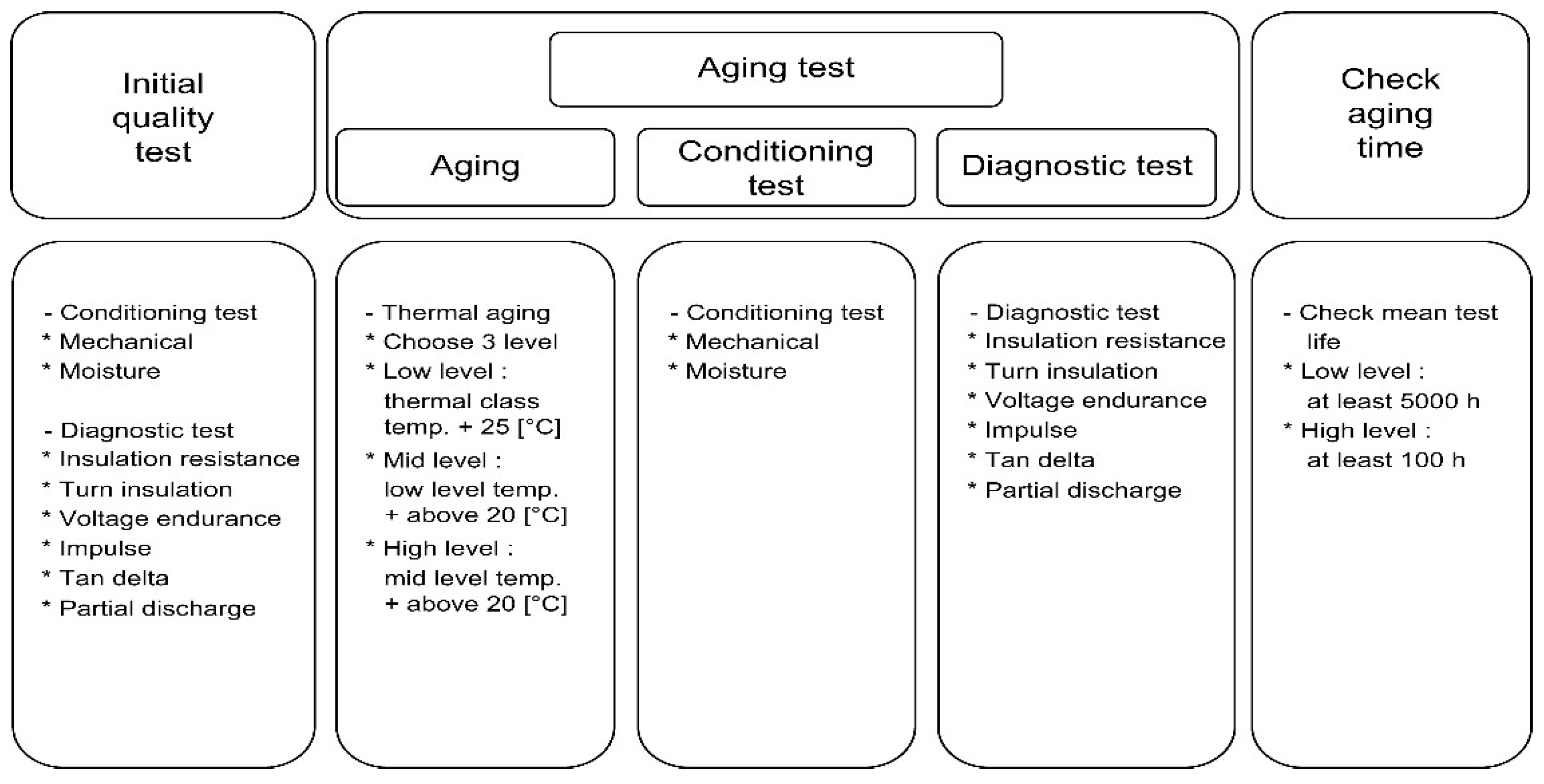
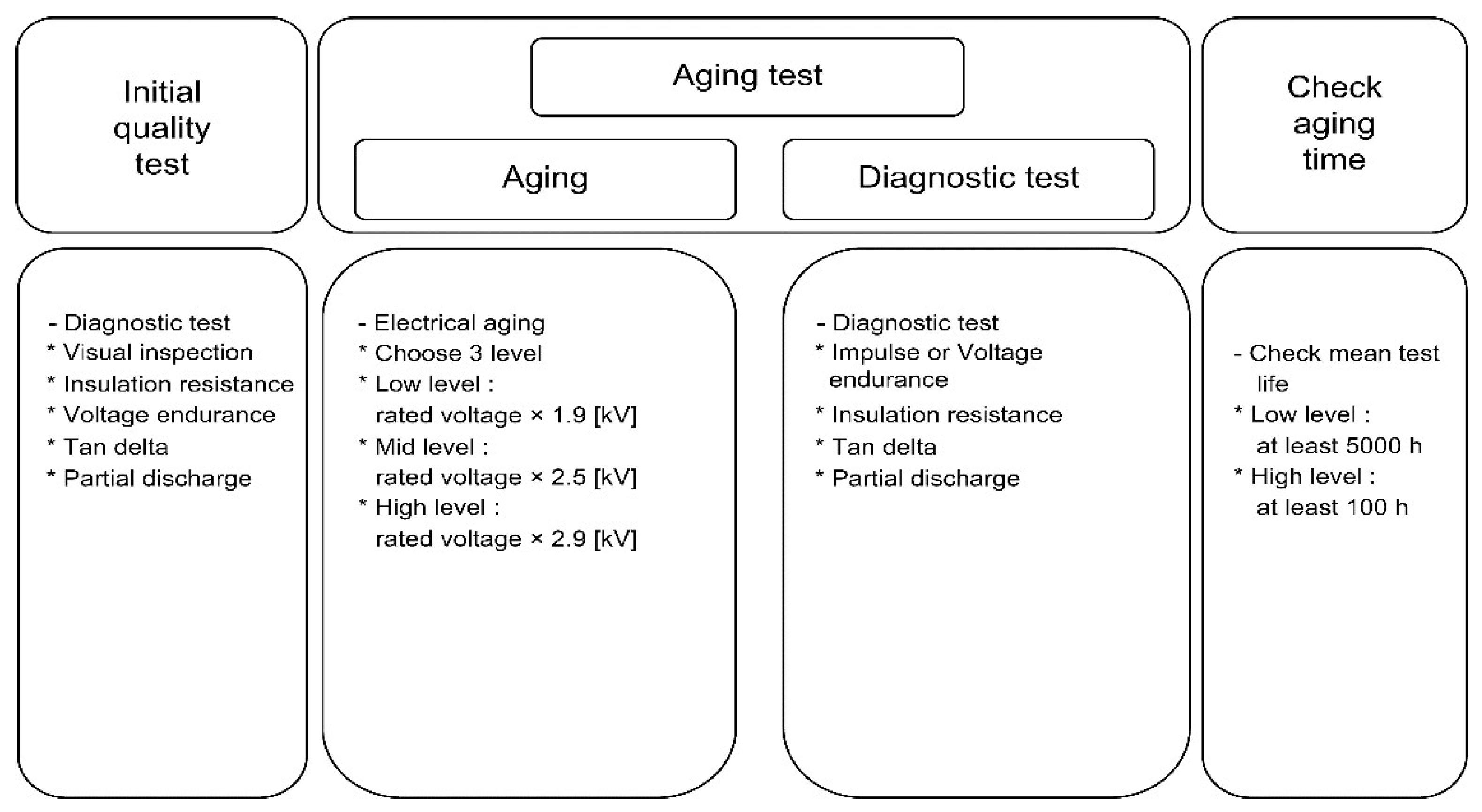
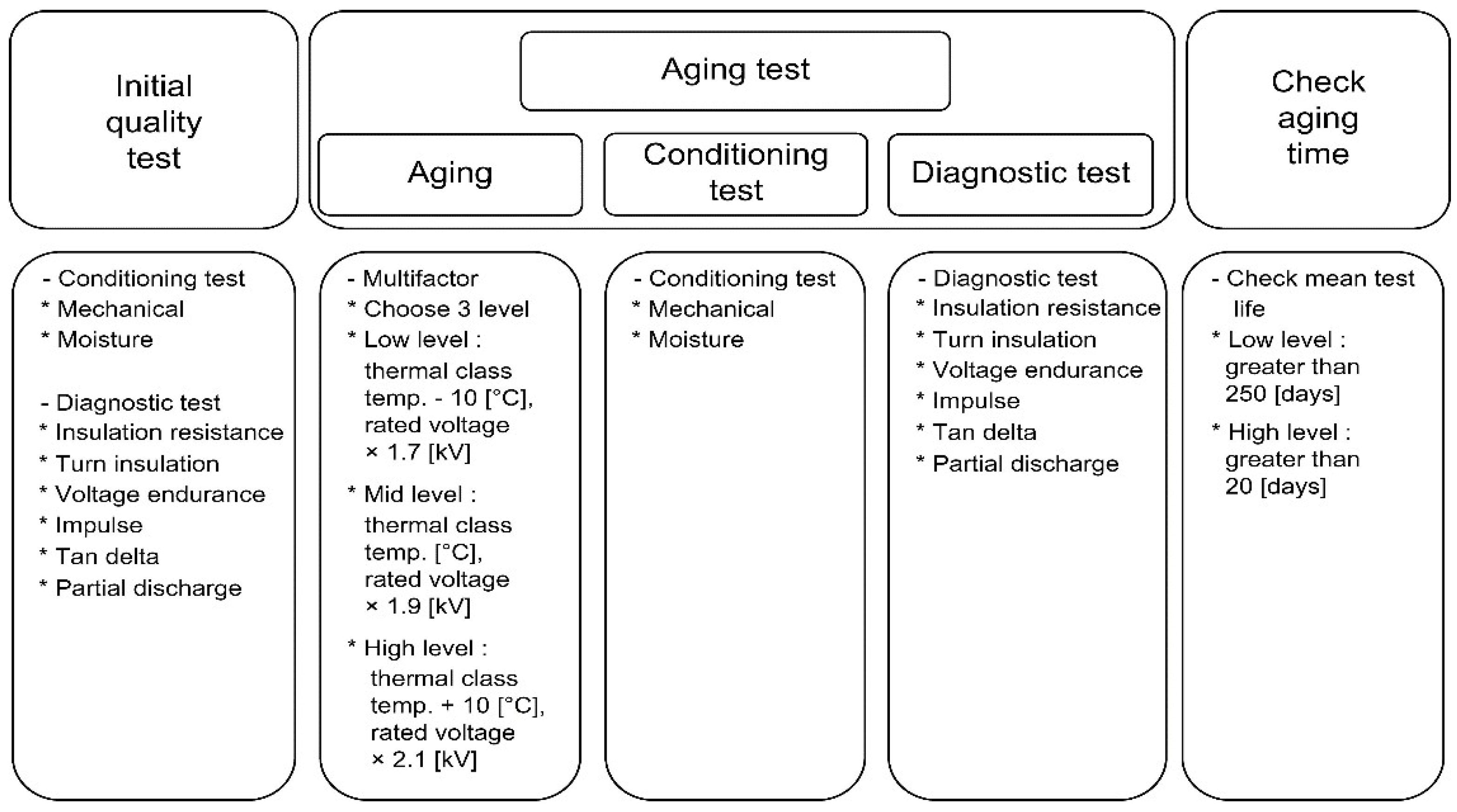
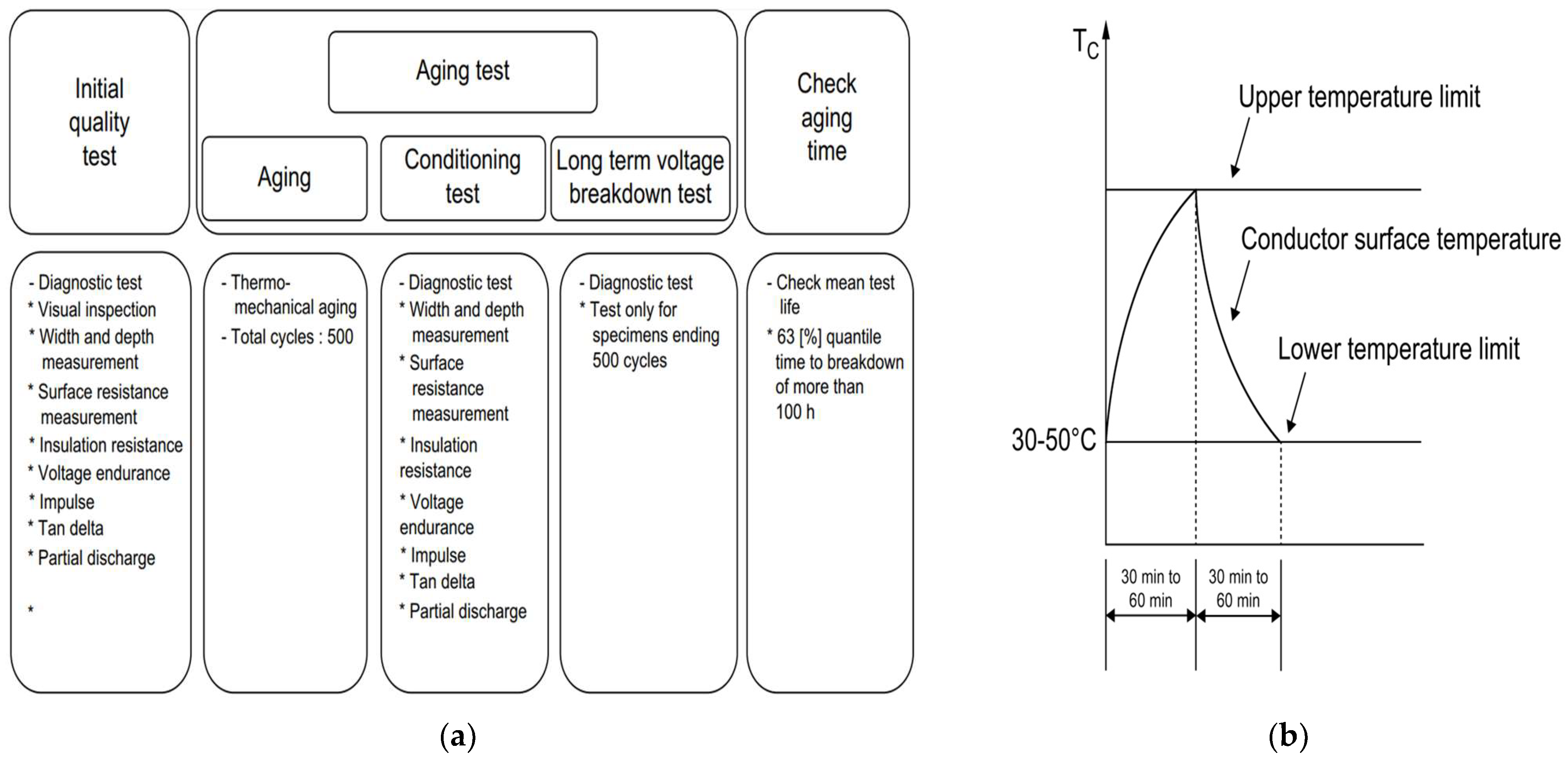
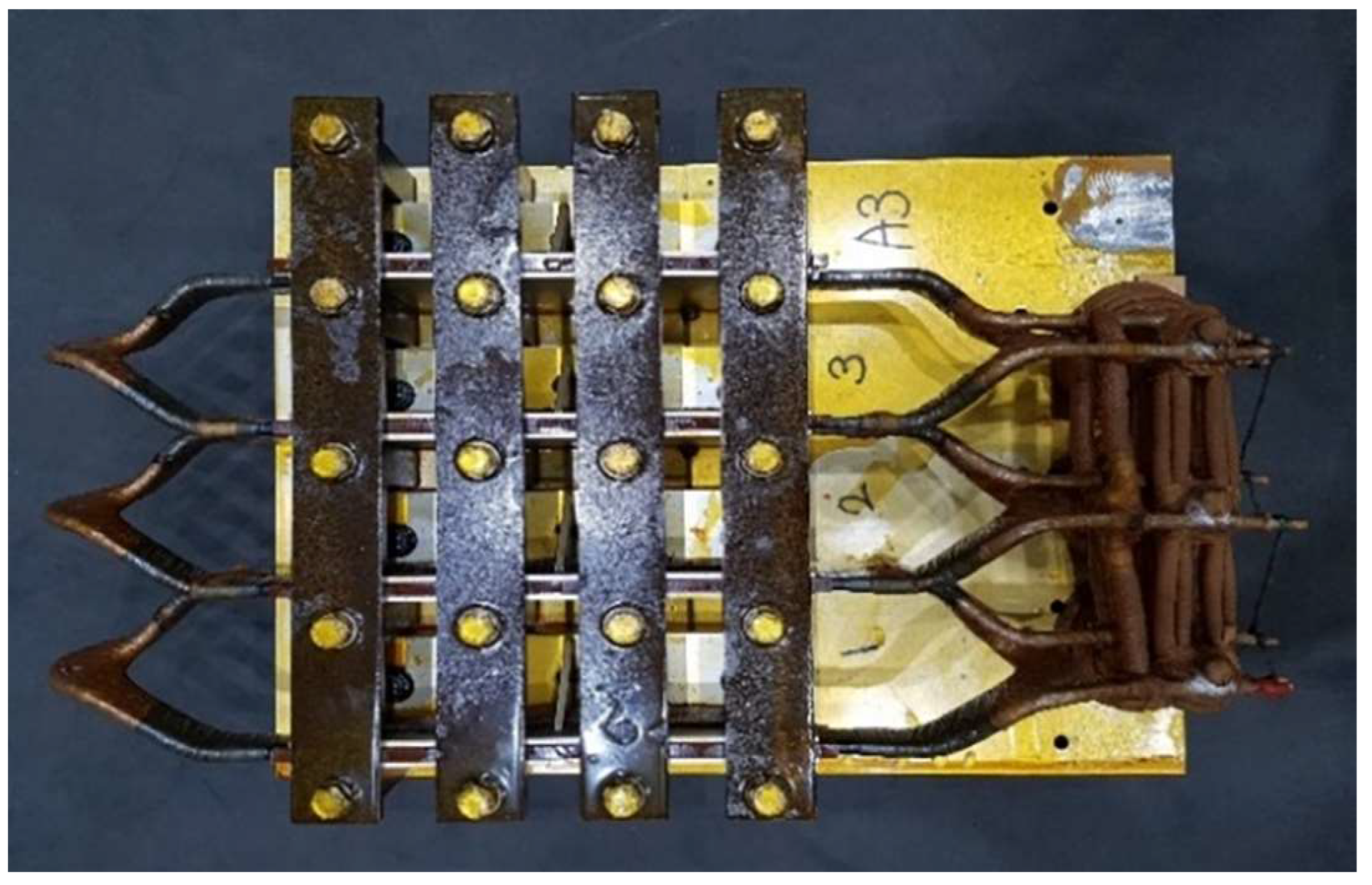
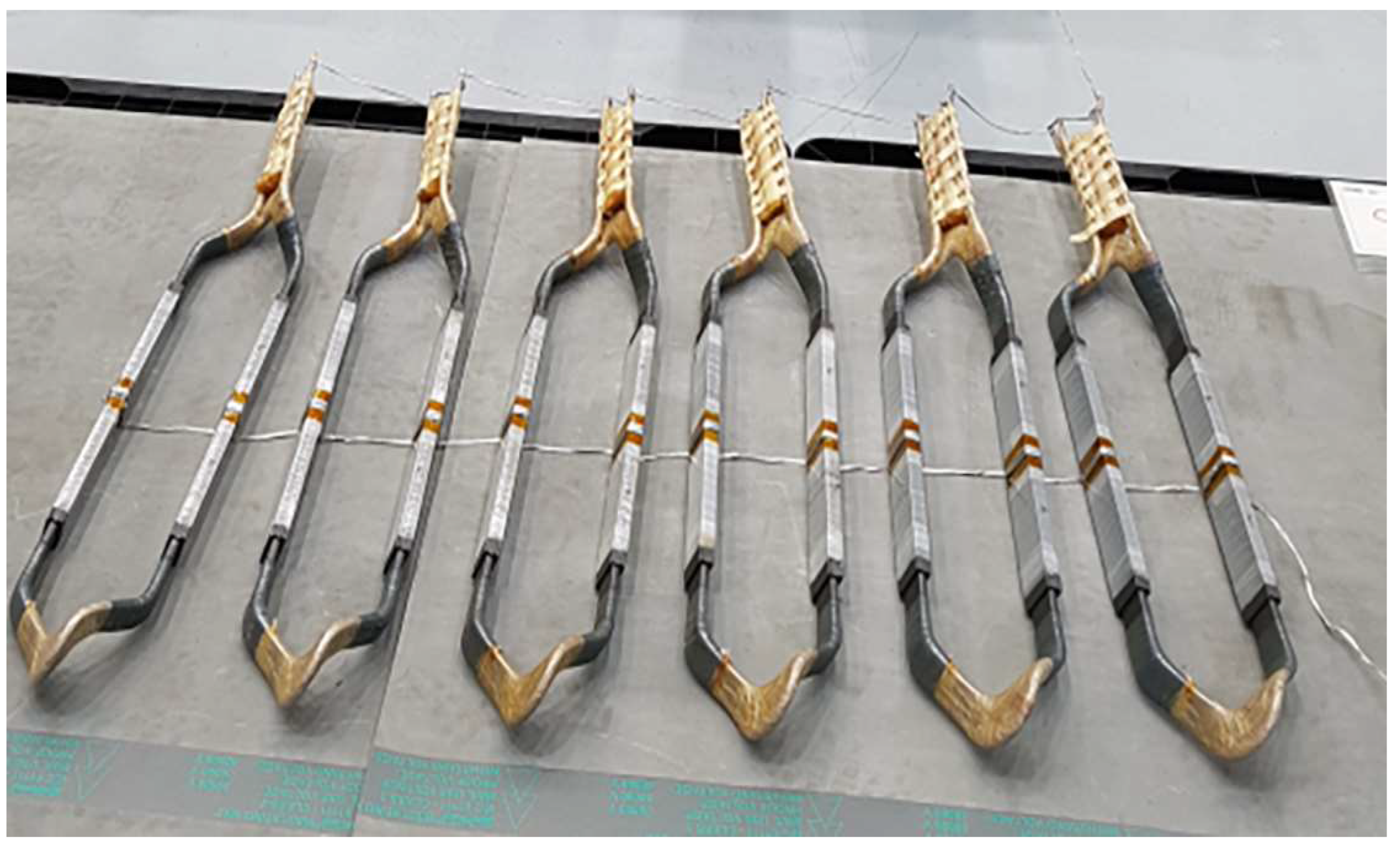
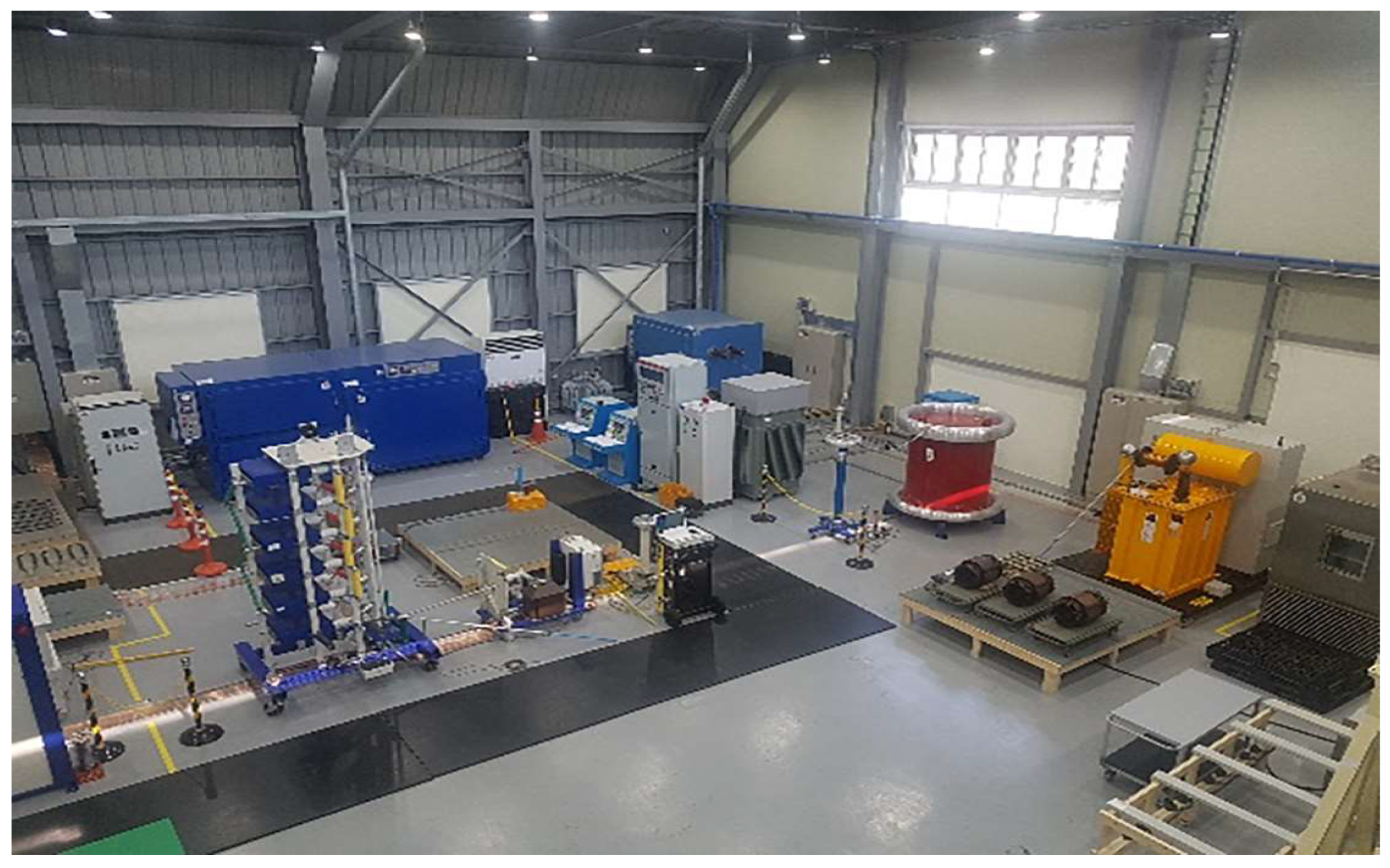
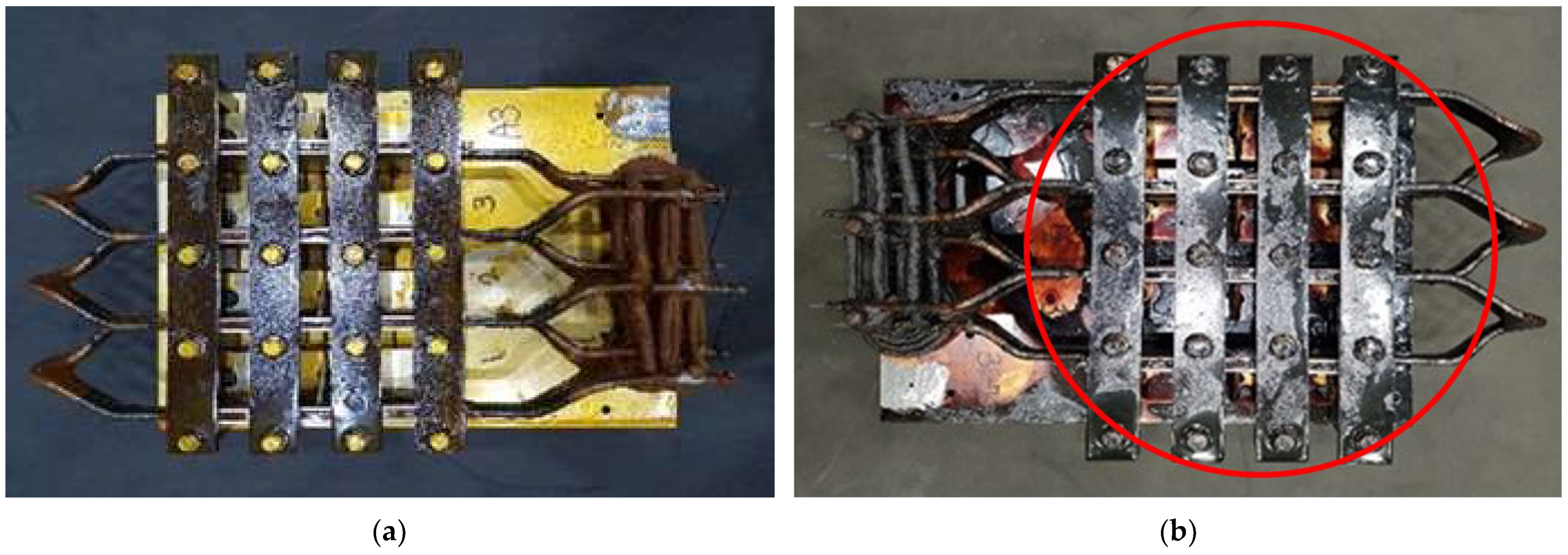

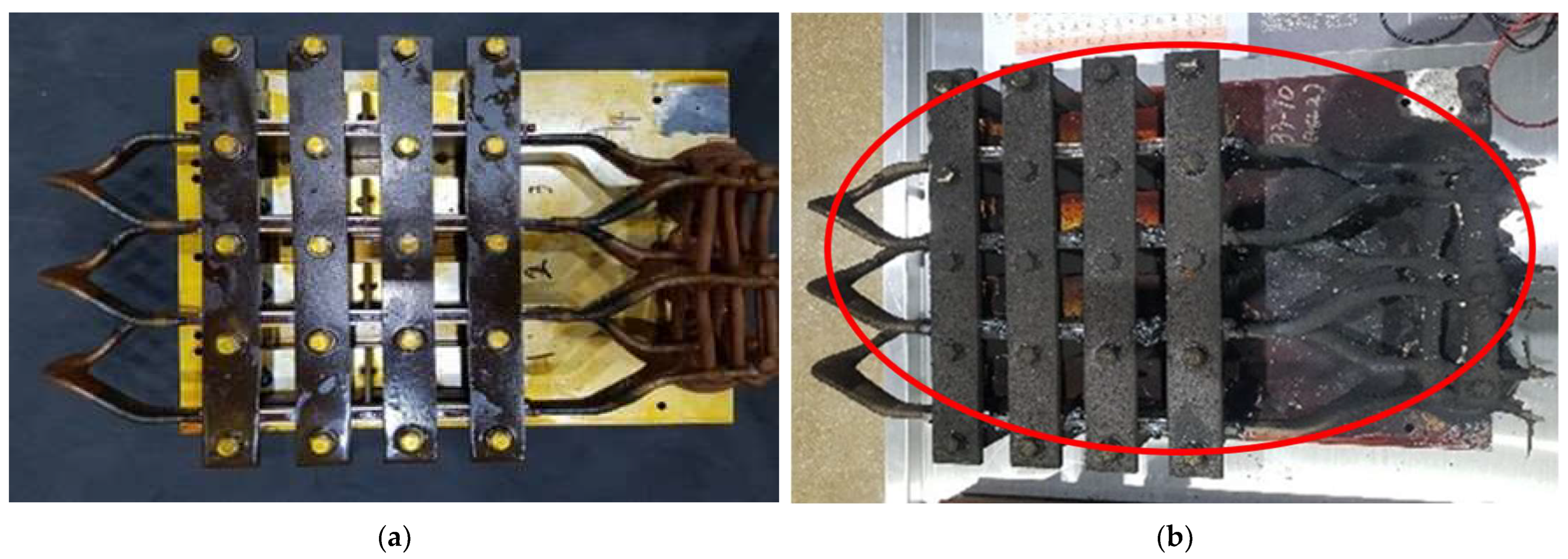

| Test Item Category | Thermal Evaluation Test Items | Electrical Evaluation Test Items | Multifactor (Thermal and Electrical) Evaluation Test Items | Thermomechanical Evaluation Test Items | |
|---|---|---|---|---|---|
| Initial quality test | - Mechanical test - Moisture test - Megger test - Turn insulation test - Voltage endurance test - Impulse test - Tan delta test - Partial discharge test | - Visual inspection - Megger test - Voltage endurance test - Tan delta test - Partial discharge test | - Mechanical test - Moisture test - Megger test - Voltage endurance test - Impulse test - Tan delta test - Partial discharge test | - Visual inspection - Width and depth measure - Surface resistance measure - Megger test - Voltage endurance test - Impulse test - Tan delta test - Partial discharge test | |
| ※ Only once before starting the aging test | ※ Only once before starting the aging test | ※ Only once before starting the aging test | ※ Only once before starting the aging test | ||
| Aging test | Aging | - Thermal aging | - Electrical aging | - Multifactor aging | - Thermomechanical aging |
| Conditioning test | - Mechanical test - Moisture test | - N/A | - Mechanical test - Moisture test | - N/A | |
| Diagnostic test | - Megger test - Turn insulation test - Voltage endurance test - Impulse test - Tan delta test - Partial discharge test | - Impulse test or voltage endurance test - Megger test - Tan delta test - Partial discharge test | - Megger test - Voltage endurance test - Impulse test - Tan delta test - Partial discharge test | - Width and depth measure - Surface resistance measure - Megger test - Tan delta test - Partial discharge test - Long-term voltage breakdown test (after completing 500 cycles) | |
| Test Item Category | Level | Number of Breakdown Specimens | Average Breakdown Time | Acceptance Criteria |
|---|---|---|---|---|
| Thermal evaluation | Low | 0 | 7056 h | At least 5000 h |
| Mid | 1 | 2096 h | At least 1000 h | |
| High | 3 | 488 h | At least 100 h | |
| Electrical evaluation | Low | 0 | 5040 h | At least 5000 h |
| Mid | 0 | 1800 h | At least 1000 h | |
| High | 3 | 142 h | At least 100 h | |
| Multifactor evaluation | Low | 2 | 258.5 [days] | Greater than 250 [days] |
| Mid | 5 | 22.3 [days] | Greater than 20 [days] | |
| High | 2 | 20.8 [days] | Greater than 20 [days] | |
| Thermomechanical evaluation | 63 [%] quantile time: 245.7 h | 63 [%] quantile time to breakdown of more than 100 h | ||
Disclaimer/Publisher’s Note: The statements, opinions and data contained in all publications are solely those of the individual author(s) and contributor(s) and not of MDPI and/or the editor(s). MDPI and/or the editor(s) disclaim responsibility for any injury to people or property resulting from any ideas, methods, instructions or products referred to in the content. |
© 2025 by the authors. Licensee MDPI, Basel, Switzerland. This article is an open access article distributed under the terms and conditions of the Creative Commons Attribution (CC BY) license (https://creativecommons.org/licenses/by/4.0/).
Share and Cite
Kim, H.-C.; Kim, J.-S. Development and Validation of Reliability Testing Methods for Insulation Systems in High-Voltage Rotating Electrical Machinery on Ships. J. Mar. Sci. Eng. 2025, 13, 186. https://doi.org/10.3390/jmse13020186
Kim H-C, Kim J-S. Development and Validation of Reliability Testing Methods for Insulation Systems in High-Voltage Rotating Electrical Machinery on Ships. Journal of Marine Science and Engineering. 2025; 13(2):186. https://doi.org/10.3390/jmse13020186
Chicago/Turabian StyleKim, Hyeun-Chul, and Jong-Su Kim. 2025. "Development and Validation of Reliability Testing Methods for Insulation Systems in High-Voltage Rotating Electrical Machinery on Ships" Journal of Marine Science and Engineering 13, no. 2: 186. https://doi.org/10.3390/jmse13020186
APA StyleKim, H.-C., & Kim, J.-S. (2025). Development and Validation of Reliability Testing Methods for Insulation Systems in High-Voltage Rotating Electrical Machinery on Ships. Journal of Marine Science and Engineering, 13(2), 186. https://doi.org/10.3390/jmse13020186







